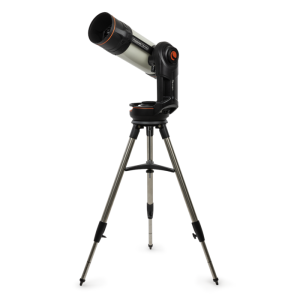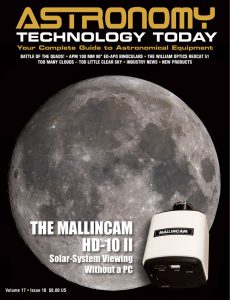The new Celestron Origin is an all-in-one home observatory designed to take the complexity out of traditional telescopes by combining a number of different Celestron innovations such as RASA optics and StarSense sky recognition technology.
 At the heart of its imaging DNA, the Celestron Origin utilizes Celestron’s patented Rowe-Ackermann Schmidt Astrograph RASA optics where the imaging sensor lies at the front of the telescope tube, not the back, creating an ultra-fast f/2.2 system with an extraordinarily wide field of view while providing sharp images to the edge. RASA’s unique combination of speed, aperture, and performance ensures unparalleled image detail, even during short exposure times.
At the heart of its imaging DNA, the Celestron Origin utilizes Celestron’s patented Rowe-Ackermann Schmidt Astrograph RASA optics where the imaging sensor lies at the front of the telescope tube, not the back, creating an ultra-fast f/2.2 system with an extraordinarily wide field of view while providing sharp images to the edge. RASA’s unique combination of speed, aperture, and performance ensures unparalleled image detail, even during short exposure times.
As the Celestron team notes, “Since it launched in 2014, RASA technology has become a go-to choice for space surveillance and satellite tracking. National defense contractors, professional research astronomers, and governments trust RASA to detect tiny pieces of debris and space junk, keeping our vital communications satellites safe in orbit. For Origin, Celestron’s optical engineers developed a brand-new 6” RASA with all the same capabilities of an observatory-grade instrument in a grab-and-go package.”
They continued, “Origin is based on the idea that a telescope and a camera sensor can “see” more than a telescope and the human eye. This is because sensors are more sensitive than the rods and cones in our eyes and can collect light over time. A system like Origin can even “stack” images together, building up light in an image with multiple short exposures. But to do this, you need a sensor that can collect lots of light in just a few seconds, depositing more and more photons into the “stacked master” image you see onscreen.”
To take full advantage of the RASA optics, Celestron selected the Sony IMX178 color CMOS sensor to capture data. It features STARVIS back-illuminated technology for the highest sensitivity and fast readout with low noise, helping to provide clear images as quickly as possible. This sensitive chip has small 2.4µm2 pixels offering a resolution that is a perfect match for the RASA fast optical design.
Origin’s built-in artificial intelligence (AI) algorithms are one of its standout features. As Origin captures data, these intelligent algorithms stack and process every frame autonomously. The result? Images that are not just good but exceptional. You’ll be amazed at the sharp details and brilliant color Origin achieves – all instantly without any user intervention. Celestron contracted with a top AI firm to develop this innovative processing technique. AI optimizes image quality by analyzing each frame to identify and reduce noise, enhance contrast, and reveal subtle details in the captured data. And because it happens in almost real-time, users can enjoy the enhanced images immediately.
The Celestron Origin offers an initialization process powered by Celestron’s StarSense technology. Simply turn on the telescope, connect to the app and then choose to remain with your telescope or leave it for remote operation. In less than two minutes, Origin focuses itself, scans the night sky, autonomously aligns itself by matching star patterns overhead to its internal database and notifies you when it’s ready to begin sky hunting.
 The Celestron Origin app was developed in collaboration with Simulation Curriculum, the makers of the popular SkySafari planetarium interface. The Origin app simplifies navigation throughout the night utilizing the planetarium view through your smart device. It’s as simple as pointing your device to the sky using “compass mode” and tap on any object you want to see (to help make choosing objects even easier, the best ones are highlighted). Or try the “Tonight’s Best” list, to choose among the most impressively visible galaxies, nebulae, star clusters, and more, all based on your precise location and observing time.
The Celestron Origin app was developed in collaboration with Simulation Curriculum, the makers of the popular SkySafari planetarium interface. The Origin app simplifies navigation throughout the night utilizing the planetarium view through your smart device. It’s as simple as pointing your device to the sky using “compass mode” and tap on any object you want to see (to help make choosing objects even easier, the best ones are highlighted). Or try the “Tonight’s Best” list, to choose among the most impressively visible galaxies, nebulae, star clusters, and more, all based on your precise location and observing time.
Once you have chosen a target, Origin centers the object precisely in the field of view. Switch to the camera view and press “Start Imaging” to begin capturing 10-second exposures. The results come through in real-time as the target takes on increased detail. As Origin works, it continually tracks the sky and adjusts its built-in dew prevention system to keep images bright and clear as they appear in view.
To share the experience, multiple people can connect to the Celestron Origin, and stream the view with their own devices utilizing the app. Additionally, Origin provides the ability to cast the live feed to a smart TV or to instantly to save and share astroimages.
To take things to another level, the Celestron Origin has a built-in filter drawer that accepts standard 1.25” and 2” format filters. This allows you to install optional filters, which can be especially useful in imaging nebulae in light-polluted environments like the typical suburban backyard. For imaging broadband objects like galaxies and star clusters or objects from dark skies, remove the filter for more light-throughput and brighter images.
If you would like to try advanced image processing, you can store all your raw images. By connecting to the telescope via USB, you can import ram images into your favorite image-processing software for manual editing and stacking.
And with the scheduled observations feature you can plan which objects you want to capture. As many objects are at their best viewing positions in the early hours of the morning the Celestron Origin can image throughout the night and you can wake up to an array of spectacular images. To capture them, simply configure a scheduled imaging session in the app and leave Origin initialized and waiting outside. At the time you specified, Origin will conduct the imaging session independently. The next morning, you’ll find the images waiting for you in the app.
 The system uses an internal Raspberry Pi computer, which resides in Origin’s rear cell, which controls the camera, focus motor, and dew prevention system. The computer also handles all the automated processes, including StarSense “plate solving,” image calibration, and stacking for the stacked master image you see in the app.
The system uses an internal Raspberry Pi computer, which resides in Origin’s rear cell, which controls the camera, focus motor, and dew prevention system. The computer also handles all the automated processes, including StarSense “plate solving,” image calibration, and stacking for the stacked master image you see in the app.
The system also offers a new mount based on Celestron’s popular NexStar Evolution computerized altazimuth mount which provides a solid base for the Origin system with the include tripod. It offers spring-loaded brass worm gears for precise tracking and manual clutches in both axes.
The Celestron Origin is a portable system that doesn’t require external Wi-Fi networks, so you can easily take it to remote dark skies. The optical tube, mount, and tripod all easily assemble and disassemble without tools and will conveniently fit into even compact cars. Each component weighs less than 16 pounds and optional carry cases are available.
The Celestron Origin all-in-one home observatory comes complete with the following:
– 6” RASA optical tube with integrated camera
– Origin single fork-arm mount with internal lithium battery
– Built-in computer with cooling fans and Wi-Fi
– Autofocuser
– Dew prevention system with environmental sensor, dew heater ring, and dew shield
– Integrated filter drawer
– Full-height tripod
– Lens cap
– AC charger
The Celestron Origin optics specifications include:
– Optical Design: Rowe-Ackermann Schmidt Astrograph
– Aperture: 152mm (5.98″)
– Focal Length: 335mm (13.18″)
– Focal Ratio: f/2.2
– Optical Coatings: StarBright XLT coatings throughout
– Central Obstruction Diameter: 63mm (2.48″) (41% of aperture diameter)
– Light Gathering Power (Compared to human eye): 474x
– Image Resolution: 1.48 arcsec/pixel
– Dovetail: CG-5 Dovetail Bar
– Filter Drawer: Integrated, accepts 1.25″ or 2″ astroimaging filters
– CMOS Image Sensor: Sony IMX178LQJ, color, back-illuminated
– Sensor Size: 8.92mm (0.35″) diagonal
– Pixel Size: 2.4μm x 2.4μm
– Number of Effective Pixels: 6.44M (3096 x 2080)
– Field of View: 1.27° x 0.85°
The Celestron Origin electronics specifications include:
– Onboard Computer: Raspberry Pi 4 Model B
– Mount: Computerized GoTo altazimuth mount
– Dew Prevention: Fully automated heating element integrated into front lens, removable dew shield/lens shade
– Focus Motor: Autofocus or manual control
– Cooling Fans: One fan for optics, one fan for electronics, both pull air through vents with wire mesh
– LED Status Ring: Indicates status “at-a-glance”
Other Celestron Origin specifications include:
– USB-A Ports: Two on optical tube for accessing raw image files for external processing, one on mount for mobile device charging only
– Ethernet Port: One on optical tube
– Auxiliary Ports: Two on optical tube, four on mount
– Battery: Integrated LiFePO4, 97.9 Wh, capable of 6+ hours of use
– Power Input:12V DC adapter for charging internal battery or running on external AC power
– Celestron Origin App: Runs on compatible iOS or Android smartphones and tablets
– App System Requirements: iOS 16 or higher, Android 12 or higher
– Optical Tube Dimensions: 609.6mm x 177.8mm (24″ x 7″) diameter
– Mount Dimensions: 457.2mm x 304.8mm x 254mm (12″ x 12″ x 10″)
– Tripod Dimensions (Collapsed): 330.2mm x 304.8 x 812.8mm (13″ x 12″ x 32″)
– Assembled System Dimensions: 609.6mm L x 660.4mm W x 1219.2mm H (24″ L x 26″ W x 48″ H)
– Optical Tube Weight: 10.6 lb (4.8 kg)
– Mount Weight: 17 lb (7.7 kg)
– Tripod Weight: 14 lb (6.35 kg)
– Total System Weight: 41.6 lb (18.87 kg)
You can learn more about the Celestron Origin all-in-one home observatory here.

 And to make it easier for you to get the most extensive news, articles and reviews that are only available in the magazine pages of Astronomy Technology Today, we are offering a 1-year magazine subscription for only $6! Or, for an even better deal, we are offering 2 years for only $9. Click here to get these deals which only will be available for a very limited time. You can also check out a free sample issue here.
And to make it easier for you to get the most extensive news, articles and reviews that are only available in the magazine pages of Astronomy Technology Today, we are offering a 1-year magazine subscription for only $6! Or, for an even better deal, we are offering 2 years for only $9. Click here to get these deals which only will be available for a very limited time. You can also check out a free sample issue here.
The Sun is more active than it’s been in years and if that’s not enough, we have the upcoming Total Solar Eclipse on April 8, 2024! If you’d like to learn more about the technology behind solar observing, solar imaging and more, you can check out our new monthly magazine – Solar Astronomy Today. It’s free to read, no subscription needed and available here. And if you are preparing for the upcoming eclipses and want to know your equipment options from solar glasses to the most out of this world solar viewing and imaging options, check out our free publication – The Definitive Guide to Viewing and Imaging the Sun – simply click here and enjoy reading!



